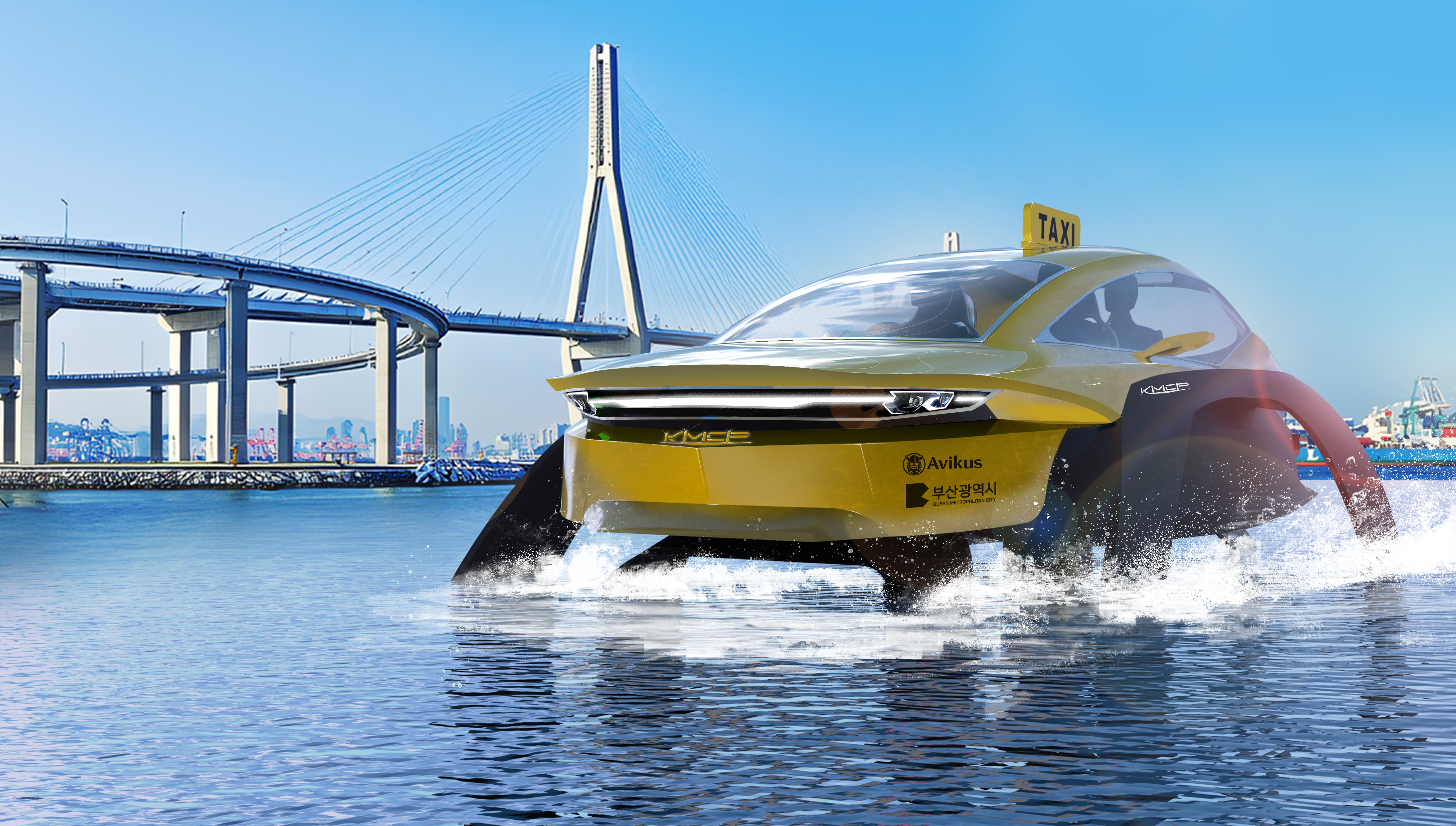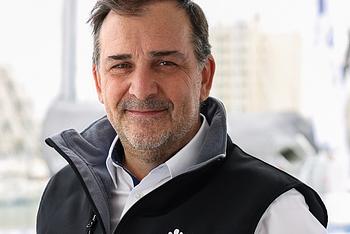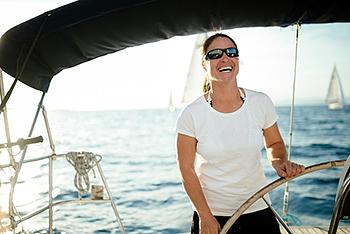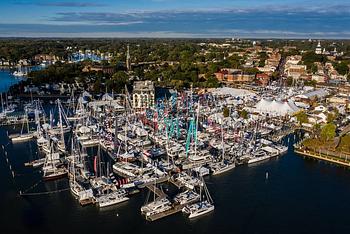Boats have changed and the way people use them has, too. First came the shift from wood hulls to fiberglass, along with the move from sail and inboard power to sterndrive and now outboards, taking over much of the market. The terminology of the boating market is now in the middle of another wholesale change, with vessels and their powerplants described as sustainable, hybrid, foiling, autonomous, and even flying. We’ve picked several that represent the future direction of boating.

The Candela P-12, currently in development, will transport passengers rapidly through congested metro areas. Photo credit: Candela Electric Boats.
Electric Power for Boats
While four-stroke outboard engines have become dominant in the powerboat market, the move to develop electric alternatives has been underway for many years, and electric-powered boats are coming on strong. Torqeedo stands out for its lightweight outboard engines, which have been working their way from tenders and other small boats into larger and larger boats; the company’s lineup now ranges from ultralight portables, to 25 and 50kW outboards, and inboard engines up to 100kW that can be tuned for planing boats (higher rpm) and displacement boats (lower rpm). (While kW and horsepower don’t always equate exactly, Torqeedo says their motors deliver from 1 to 100 hp.)

Electric outboard power is coming to the mass market; one of the first to be developed is the four Winns H2E. Photo credit: Four Winns Boats.
Vision Marine Technologies seized the headlines last year with a record run for electric-powered boats, hitting 109 mph a the Lake of the Ozarks Shootout, and Groupe Beneteau, the world’s largest recreational boatbuilder, has now teamed up with Vision to integrate electric power with its iconic American brand, Four Winns. The sport H2e bowrider will be the first model launched, carrying Vision’s 2 high-voltage, high-density 700v battery packs and a fully integrated system onboard to plug into dock shore power for quick charging.

Powered by Vision Marine Technologies outboards, this V32 catamaran hit 109 mph, setting a new world record for electric power in 2022. Photo credit: Vision Marine Technologies.
Electric-Powered Foiling Boats
Improving battery technology is key to the development of electric power on boats in the future, but it’s not the only way to extend the range and performance of these vessels. Here are a couple of electric-powered vessels from one leading company that serve different purposes. The Candela P-12 will replace the common road-bound bus in certain metro areas like Stockholm, Sweden. The foiling catamaran design is stable and its batteries can be regularly charged in short fast-charge facilities to provide economical, ecological, moderately fast and silent public transportation.

The Candela C-8 is a futuristic foiling runabout that’s already making an impact on the marketplace. Photo credit: Candela Electric Boats.
For boaters looking to replace their high-powered gas-guzzling runabouts, the Candela C-8 is already on the market and flying on foils, stabilized by half a dozen downward-aimed radar sensors that provide input to dedicated software on sea state variation 100 times a second. The model won the European Boat of the Year award recently, and while it has limits in its weight-carrying capacity and range, the company has made big steps forward from its previous, C-7 model…plus you’ll get where you’re going so fast that you’ll have plenty of time to charge up for the return trip.

Watch for superyachts to sprout wingsails in the future, and with the addition of solar panels and hydrogen fuel cells on boats such as the Alva Ocean Eco 90, power may come almost entirely from renewable sources. Photo credit: Alva Yachts.
Sustainable Superyachts
Call it an oxymoron because, honestly, superyachts have a long way to go to be carbon neutral, but a yacht like the 90-foot Alva Ocean Eco will take giant steps towards becoming the sustainable superyacht. Powered in great part by 2152 square feet of “Solar Roof” glass tiles and 2 500kW gearless electric drives, the catamaran cruiser can also be fit with hydrogen fuel cells and supplied by hydrogen storage tanks as an option. Cruising speeds for max range are 8 to 10 knots, with a top speed of 15 to 16. Alva is even developing an option for adding highly efficient wingsails to add free power whenever a breeze is blowing. One thing we can count on is that whatever works at this scale, where development money is often available, will likely move into the larger recreational boating market as pricing improves.

Equipped with four wingsails, Canopée will soon be moving rocket parts on a transatlantic route while using only half the fuel it would otherwise burn. Photo credit: Ariane Group.
Wind-Assisted Cargo Ships
Ideas for rigging masts to container ships and other commercial vessels have been floated for quite some time, but Canopée is in the water and undergoing sea trials already. The 121-meter design was developed by the vaunted sailing yacht design firm VPLP and its partner, the shipping company Alize. The project is for Ariane Espace to build a ship that will transport parts of the Ariane 6 rocket from Europe to French Guiana in South America and be able to navigate the shallow Kourou River on arrival. Working the traditional sailing trade routes from the Golden Age of Sail, it is estimated this vessel will be able to make the trip on only half the fuel of a conventional cargo ship.

Capitalizing on VPLP’s decades of success with ocean sailing record setters, Vela will make faster transatlantic deliveries using much less fuel. Photo credit: VPLP Design.
More recently, VPLP was hired to develop the 65-meter trimaran, Vela, which aims to deliver 350 tons of cargo from France to New York in under two weeks, a week faster than a conventional freighter, including loading and unloading. VPLP has designed multihull racing sailboats to break ocean-passage sailing records, so they have the chops to design fast boats that can hold up in tough conditions offshore. This vessel carries her own crane and can load and unload independently of shoreside support allowing her to call on secondary ports as well. The first Vela sailing ships are scheduled to start sailing in 2025.

Seventy-five feet long and capable of speeds close to 60 mph, the foiling AC75 design of Emirates Team New Zealand began testing in Auckland and has now been shipped to Barcelona, Spain, to defend the America’s Cup in 2024 for New Zealand. Photo credit: Emirates Team New Zealand.
Sailboat Racing Achieves Lift-Off
In recent years, the direction of top-end sailboat racing has only been going up. Super high-speed racing sailboats have been equipped with foils that allow them to rise completely out of the water and operate in a foil-borne state. While spectacular crashes ensue occasionally, the speeds of boats like the 75-footers that will compete in next year’s America’s Cup in Barcelona, Spain, now exceed 50 knots (57+ MPH).

Flying high, the IMOCA 60 Malizia, is equipped with a pair of C foils, a daggerboard and two rudders; on a recent transatlantic leg of The Ocean Race, the 60-foot boat broke the 24-hour monohull sailing speed record, set by a 100-footer, by more than 20 miles. Photo credit: Antoine Auriol/Team Malizia/The Ocean Race photo.
The IMOCA 60-foot class has been optimized for sailing farther—all the way around the world—and their foils lift all but the stern of the boat clear of the waves. In the 2023 Ocean Race, the German boat Malizia sailed 641.13 nautical miles in 24 hours.

The Ultim 100 SVR Lazartigue rounds Fastnet Rock en route to winning the 2023 Rolex Fastnet Race from the U.K., to Ireland, and finishing in Cherbourg, France. Photo credit: ROLEX/Kurt Arrigo photo.
Yet the fastest of all ocean greyhounds under sail are the Ultime trimarans, approximately 100 feet long. They are also foil-assisted and can jog along at speeds over 40 knots. They often compete with each other to set new around-the-world records; the current record is 40 days, 23 hours, 30 minutes, set in 2017 by IDEC Sport, a 103-foot trimaran skippered by Francis Joyon. In the right conditions, like the America’s Cup boats, these offshore sailing machines can hit speeds close to 60 mph; in the case of IDEC Sport, the vessel sailed around the world for 26,412 miles at an average speed of 26.85 knots (30.9 mph).

A fleet of water taxis using HD Hyundai’s autonomous navigation system, will soon be ferrying passengers from dock to dock in downtown Busan City, Korea. Photo credit: Avikus.ai
Autonomous Vessels
Autopilots have been fitted to boats and yachts of all sizes, allowing a skipper to take their hand off the wheel for periods, knowing that a capable digital assistant will steer their vessel on a compass course or to a designated waypoint on a digital chart. Autopilots can also sail a boat at a constant angle to the wind and even automatically hold a designated GPS position with devices such as the Sky Hook made by Mercury Marine, connecting the boat’s engines to the output from a GPS receiver. Yet we haven’t heard of too many boats fitted out to be completely “driver-less.” It appears that will change soon if HD Hyundai’s Avikus has anything to do with it—be on the lookout for their new fleet of six-seat water taxis, to be introduced in the downtown area of Busan City, Korea. The company already has a navigation solution for cargo ships and is adapting it for leisure boats under the name NeuBoat NAVI; the software sets safe routes and provides alerts, and will be capable of providing autonomous navigation, obstacle detection, and avoidance control. The NeuBoat DOCK system will bring the taxis into and away from designated passenger docks. Also, don’t worry about paying with exact change; we’re pretty confident there will be an app for that.

Designed to fly over coastal waters only, the quarter-scale, all-electric technical demonstrator built by Moore Brothers for Regent Craft takes off on Narragansett Bay, Rhode Island. Photo credit: Regent
Near-Water Flying Boats
The “surface-effect” boats in development in Rhode Island, USA, recently are boats in name only (classified that way by the U.S. Coast Guard) and aim to become the fastest transport over water, attaining speeds up to 180 mph while carrying up to 12 passengers and 2 crew. More accurately called seaplanes or seagliders, the vessels are known as “wing-in-ground-effect” vehicles, relying on what’s called “ground effect” of reduced aerodynamic draft generated by an aircraft’s wings when close to a fixed surface (like water). These electric-powered flyers will pick up their passengers at a dock, idle into more open water, then take off, first rising onto their foils and then lifting clear of the water. The transition to carbon-composite foils before taking flight reduces the power requirement to achieve lift-off, thus saving on weight. To help with the strength-to-weight development, the foil expertise of America’s Cup sailing engineers has been brought into the development process, as well. To date, Regent has built and successfully tested a quarter-scale model built out of carbon fiber at Moore Brothers, a boat-component specialist in Bristol, R.I. Next up is the full-size prototype.

The 1929 Sparkman & Stephens design Dorade is a narrow, wet, and beautiful classic yacht when racing in a strong breeze, as here at Audi Hamilton Island Race Week in 2017. Photo credit: Andrea Francolini/Audi photo
Ageless Classics
The future of boating will not be a pure technology race. In some cases, it will be the same as it ever was, with yacht owners lavishing love, money, and varnish on timeless classic yachts such as Dorade, the 94-year-old yawl that launched the Sparkman & Stephens yacht design dynasty in 1930. Considered too diminutive for true ocean racing at the time, the 52-foot vessel won a slew of ocean races including the Newport Bermuda Race, the Transatlantic Race, the Fastnet Race, and the Transpacific Race in its first six years. When her current owners bought the boat in 2010, they restored it thoroughly to racing condition, then repeated and finished surprisingly well in all of those races, improbably taking first overall in the 2013 Transpac against a modern fleet. Kept in pristine condition, yachts such as Dorade are as much a part of the future of boating as the highest and latest technology designs.





